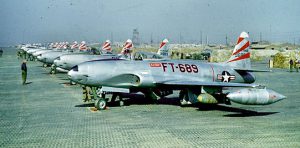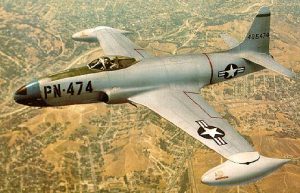Lockheed P-80 Shooting Star Jet Fighter

In the waning days of World War II, the US military rushed four hush-hush experimental fighters without propellers to the European front. Unbeknownst to the bewildered ground crews arming them, these Lockheed P-80 Shooting Star aircraft would usher in a new “jet age” just as revolutionary for the US Air Force as the tank was for the Army.
The P-80 started in 1944 as an ultra-secret crash program. It was to counter the German Me-262, the world’s first jet fighter and one busy slaughtering B-17’s over the Continent. Despite Lockheed Martin designing and delivering battle-worthy prototypes in just 146 days, the Shooting Star never had a chance to see combat in WWII. Which was probably just as well, since the early variants were quite unreliable. At least five test pilots were killed in XP-80 crashes, including Major Richard Bong, the top-scoring USAAF ace of the war.

Trial By Fire:
Still, by the time the Korean War broke out, many of the lethal kinks had been hammered out of America’s first true jet fighter. Even if non-fatal crashes were still too common. In the first six months of the war, P-80’s claimed 75% of enemy aircraft kills. Early in the conflict, a P-80 Shooting Star flown by Lt. Russell Brown shot down a North Korean MiG-15—the cutting edge of jet fighter technology at the time—during the first jet-versus-jet air battle in history.

Firepower:
Armed with six .50-caliber machine guns and up to 2,000 pounds of ordinance, Shooting Stars routinely wreaked havoc on North Korean and Chinese ground troops as well. This wasn’t without sacrifice. Approximately 30% of the total P-80 fleet were lost in Korea, 113 from ground fire and 14 shot down by enemy aircraft (usually Mig-15’s).

Tech Demonstrator:
While soon replaced by the swept-wing F-86 at the end of the Korean conflict, the P-80 set some impressive records in its short service history. One of the jet’s most important non-combat uses was serving as a test bed for new technologies. In fact, the P-80 became the first fighter to be equipped with an ejection seat.

Setting Records:
The Shooting Star couldn’t break the sound barrier on account of its straight-wing design. However, they routinely set records for long-endurance high-speed flights just under the speed of sound. In 1947, a P-80 Shooting Star made the first transcontinental nonstop jet flight across the US, a distance of 2,457 in only 4 hours and 13 minutes at an average speed of 584 mph.
During the Berlin airlift of 1948, a squadron of the P-80 Shooting Stars were scrambled to defend the transports from Soviet Aggression. They completed the first non-stop Atlantic crossing by a single-engine jet aircraft and were on station in West Germany in less than a day.

Perhaps the Shooting Star’s most famous legacy is the venerable T-33 trainer, which directly evolved from the P-80D and remained in US service until 1997.
See P-80 Shooting Star Specifications
| Crew: 1 |
| Length: 34 ft 5 in (10.49 m) |
| Wingspan: 38 ft 9 in (11.81 m) |
| Height: 11 ft 3 in (3.43 m) |
| Wing Area: 237.6 ft² (22.07 m²) |
| Aspect Ratio: 6.37 |
| Empty Weight: 8,420 lb (3,819 kg) |
| Loaded Weight: 12,650 lb (5,738 kg) |
| Max. Takeoff Weight: 16,856 lb (7,646 kg) |
| Powerplant: 1 × Allison J33-A-35 centrifugal compressor turbojet, 4600 lbf (20.46 kN) / 5400 lbf (24.02 kN) with water injection |
| Zero-lift Drag Coefficient: 0.0134 |
| Drag Area: 3.2 ft² (0.30 m²) |
| Maximum Speed: 600 mph, Mach .76 (P-80A 558 mph at sea level and 492 mph at 40,000 ft)(965 km/h) |
| Cruise Speed: 410 mph (660 km/h) |
| Range: 1,200 mi (1,930 km) |
| Service Ceiling: 46,000 ft (14,000 m) |
| Rate of Climb: 4,580 ft/min (23.3 m/s) 5.5 min to 20,000 ft (6,100 m) |
| Wing Loading: 53 lb/ft² (260 kg/m²) |
| Thrust/Weight: 0.364 (0.427 with water injection) |
| Lift-to-Drag Ratio: 17.7 |
| Guns: 6 × 0.50 in (12.7 mm) M3 Browning machine guns (300 rpg) |
| Rockets: 8 × 127mm unguided rockets |
| Bombs: 2 × 1,000 lb (454 kg) bombs |

